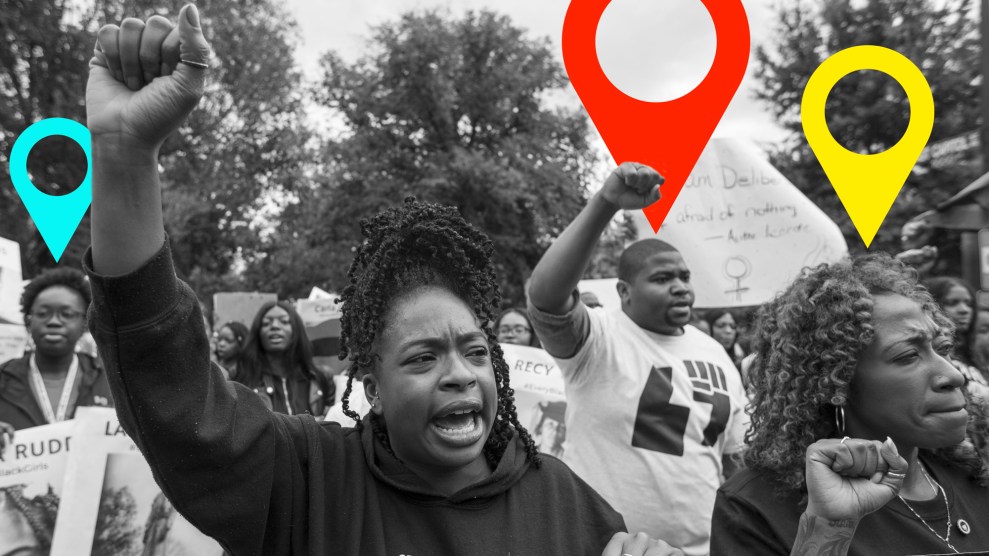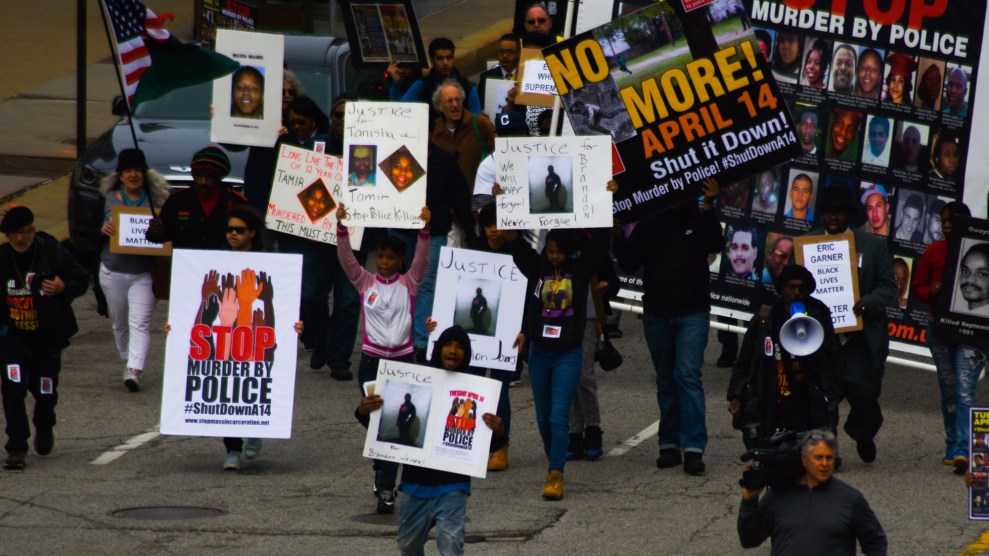
Alex Edelman/Zuma/iStock/Getty Images
Many people in the Black Lives Matter movement got involved out of a belief that police routinely target black people for abuse. Now BLM activists are accusing a local police department of illegally targeting them for trying to call awareness to that abuse.
In August, the Black Lives Matter Global Network chapter in the Rockland County, upstate New York, filed a federal lawsuit claiming police in Clarkstown, a city of about 84,000 people, spied on its members unlawfully for at least a year, from January through December 2015.
Court documents provided by plaintiff attorney William O. Wagstaff III, including reports and internal communications from the department’s Strategic Intelligence Unit, make up the basis for the group’s allegations that Clarkstown police racially profiled the group’s members and violated their rights to free speech and assembly.
The documents show that the police department’s Strategic Intelligence Unit— established in 2013 between the department and the county DA’s office to gather intelligence on suspected criminals—conducted social-media surveillance on BLM activists and continued to do so even after the unit’s supervisor was told by the lead detective in the prosecutor’s office that the surveillance had to stop.
BLM activists elsewhere have long suspected that police were monitoring them, but the Clarkstown documents constitute some of the clearest evidence yet of such surveillance. According to a November 2015 police intelligence report, the special unit used a “geofence” twice that month to monitor Twitter and/or Instagram feeds of individuals it determined were affiliated with the BLM movement. Geofences, which businesses use to create targeted advertising, allow users to track social media posts within a given time frame, and store and analyze time and location data. The intelligence report does not specify how many people were tracked in each instance. A report for the following month shows that police tracked the social media activity of Black Lives Matter activists on six occasions. The goal, according to the reports, was to disrupt potential violence.
Mother Jones also obtained an email exchange in which Peter Modafferi, former chief detective for the Rockland County DA’s office, indicates that he’d already warned Sgt. Stephen Cole-Hatchard, the former head of Clarkstown’s Strategic Intelligence Unit, about the monitoring: “Steve,” Modafferi wrote, “I mentioned before, you really should not have Black Lives Matter listed as a target of surveillance.” (Neither the police department nor the parties in the emails responded to requests for comment for this story.)
According to the department’s reports, Clarkstown police used “a social media monitoring platform and other investigatory tactics” to “search, monitor and analyze real time social media content” of surveillance targets, including suspected terrorists, gangs, and drug traffickers. It is unclear what the “other” tactics consisted of, but documents in another case filed by Clarkstown city attorneys described the BLM surveillance conducted by the intelligence unit as “unlawful.”
Chris Conley, an attorney with the ACLU of Northern California, says the case gets into largely uncharted legal waters. “You are collecting lots of information that is publicly available—is that a problem?” he says. “If I can look at one tweet, why can’t I suck them all up? The question still hasn’t been fully answered.” He adds: “I don’t think there would be any question that an officer sitting at a laptop and going to Twitter and digging around on things would be constitutional. The question is, does it change when it goes from individual manual investigations to bulk surveillance?”
Some companies have taken flack for pitching geofencing to law enforcement as a surveillance tool. In 2016, for instance, Facebook, Instagram, and Twitter terminated access to all or part of their user data for Geofeedia, one of the largest providers of geofence technology, after the ACLU of Northern California revealed that Geofeedia was using those partnerships to market its technology to police, specifically as a tool to target Black Lives Matter protests.
As a rule, says Susan Freiwald, a professor at the University of San Francisco Law School, police should not be tracking people without legitimate suspicion that they are involved in criminal wrongdoing. Conley adds that the storage of social-media information would raise additional constitutional concerns. “Basically, police would be able to investigate the people who are running the protest and the people who are participating, keep a file on them, and keep tabs on who’s involved—and that’s not what police are supposed to be doing.”
This past April, the Guardian published internal NYPD communications showing that officers had accessed text messages of activists who had organized Black Lives Matter protests. In June, the Washington Post wrote that BLM activists—well aware of the FBI’s history of surveillance against civil rights leaders and the Black Panthers—were increasingly turning to encrypted messaging apps such as Signal to protect themselves. More recently, CNN reported that the Justice Department had obtained search warrants to access Facebook accounts of “anti-administration activists.”
Finally, earlier this month, Foreign Policy revealed that the FBI had identified a new surveillance category for “black identity extremists”—people analysts felt might attack police in retaliation for police violence against African Americans. Rep. Cedric L. Richmond, chairman of the Congressional Black Caucus, told the New York Times he worried the feds would use the new category as a pretext for spying on black people who engaged in lawful protest activities.
The BLM suit also claims Clarkstown police put snipers on the roofs of buildings during rallies the local BLM chapter held. Those rallies took place in Nyack and Clarkstown in the summer of 2016. “The intention is to illegally surveil people with the hope that they can silence them,” Wagstaff told me. BLM is seeking unspecified monetary damages and a cease-and-desist order by the court against the intelligence unit, whose reports are shared with nearby law enforcement agencies and with the US Department of Justice.
The BLM suit has a precedent. In July 2016, Clarkstown police chief Michael Sullivan was suspended, in part because of evidence that his intelligence unit conducted illegal surveillance on a community group called We the People, as well as the Rockland County BLM chapter. A special prosecutor had been hired by the town supervisor (the equivalent of a mayor) to investigate the unit and had uncovered evidence of improper surveillance targeting Sullivan’s perceived political enemies—including the county sheriff, a judge, the supervisor himself, and even residents who supported cutting the police department’s budget. The investigation resulted in more than a dozen disciplinary charges against Sullivan—who was found guilty for 11 of them. He was fired in September 2017.
In January, We the People filed a lawsuit claiming Clarkstown’s police intelligence unit had tracked the social media activity of 13 of its members, nearly all black, after they promoted a play online about a white cop who’d shot a black off-duty colleague. Wagstaff also represented those plaintiffs, who settled their case in July for $300,000.
















